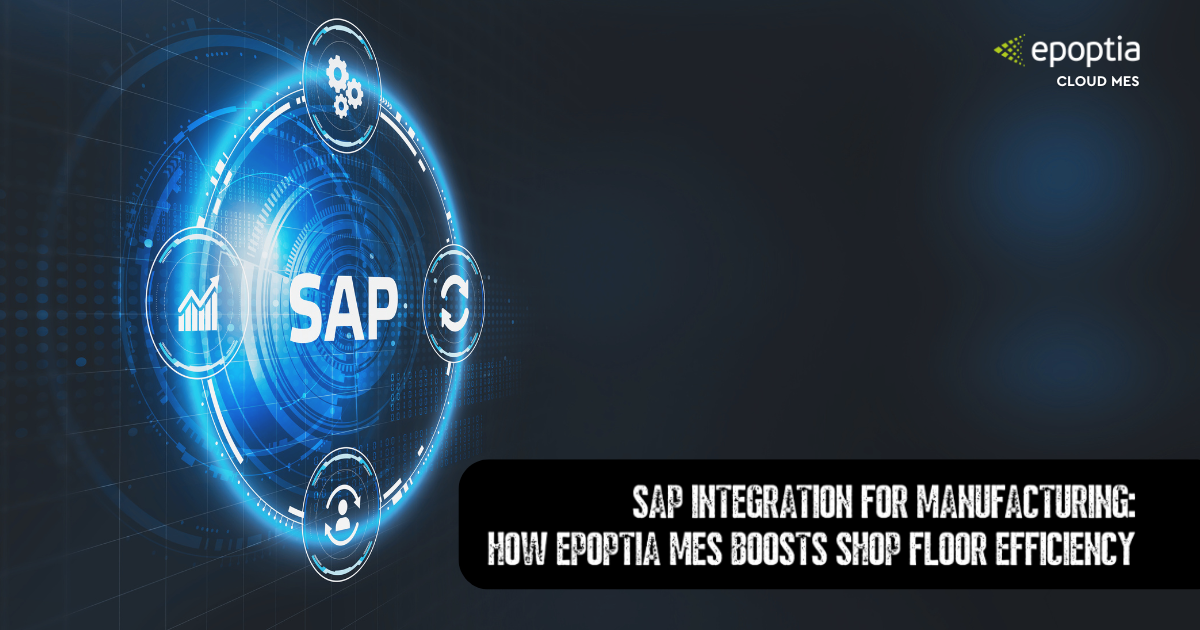Ανακαλύψτε πώς το Epoptia MES ενισχύει το SAP με έλεγχο σε πραγματικό χρόνο, απρόσκοπτη ανταλλαγή δεδομένων και παραγωγή χωρίς χαρτιά.
Οι σύγχρονοι κατασκευαστές χρειάζονται ταχύτητα, ιχνηλασιμότητα και ευελιξία στο εργοστάσιο. Ενώ το SAP υπερέχει στη διαχείριση του σχεδιασμού και των επιχειρηματικών λειτουργιών σε επίπεδο επιχείρησης, δεν σχεδιάστηκε με γνώμονα τις λειτουργίες του εργοστασίου πρώτης γραμμής. Ως αποτέλεσμα, οι εταιρείες αντιμετωπίζουν διάφορες προκλήσεις: οι πληροφορίες από την παραγωγή καθυστερούν, οι ενέργειες καταγράφονται χειροκίνητα και οι χειριστές συχνά παλεύουν με ένα πολύπλοκο περιβάλλον εργασίας χρήστη. Αυτή η αποσύνδεση μεταξύ σχεδιασμού και εκτέλεσης μπορεί να κοστίσει χρόνο, χρήμα και ποιότητα.
Ευτυχώς, υπάρχει λύση.
Το Epoptia ως ένα έξυπνο τερματικό SAP για το κατάστημα
Αρχικά, για να γεφυρωθεί το χάσμα μεταξύ του προγραμματισμού σε επίπεδο επιχείρησης του SAP και των ταχέως εξελισσόμενων απαιτήσεων σε πραγματικό χρόνο των περιβαλλόντων παραγωγής, οι κατασκευαστές στρέφονται στο Epoptia MES. Ειδικά σε περιβάλλοντα job shop, όπου η ευελιξία της διαδικασίας, η ιχνηλασιμότητα και η γρήγορη λήψη αποφάσεων είναι ζωτικής σημασίας, η Epoptia προσφέρει μια προσαρμοσμένη λύση που ενδυναμώνει το χώρο του εργοστασίου.
Το Epoptia χρησιμεύει ως ένα έξυπνο, διαισθητικό επίπεδο MES που επιτρέπει στις ομάδες παραγωγής να αλληλεπιδρούν αποτελεσματικά με το SAP. Αντί να αντλεί δεδομένα απευθείας, το Epoptia λαμβάνει εντολές παραγωγής, κέντρα εργασίας, δεδομένα δρομολόγησης και πολλά άλλα μέσω συνδέσεων API, εξασφαλίζοντας ασφαλή, παραμετροποιήσιμη και συμβατή με το SAP ολοκλήρωση. Στη συνέχεια καθοδηγεί τους χειριστές μέσω των σωστών βημάτων σε πραγματικό χρόνο και στέλνει επικυρωμένη ανατροφοδότηση πίσω στο SAP, όπως ολοκληρώσεις, κατανάλωση υλικών και παρακολούθηση εργασίας.
Ενώ το SAP έχει σχεδιαστεί για τη διαχείριση υπολογιστικών δεδομένων, το Epoptia έχει κατασκευαστεί για να χειρίζεται τις πραγματικότητες του περιβάλλοντος παραγωγής - γεφυρώνοντας τον κόσμο των ψηφιακών συστημάτων με τον φυσικό κόσμο των μηχανών, των υλικών και των ανθρώπων. Αυτό εξασφαλίζει ζωντανή ορατότητα, ακριβή συλλογή δεδομένων στην πηγή και εξορθολογισμένες ροές εργασίας σε όλο το χώρο του εργοστασίου.
Τεχνική ενσωμάτωση: Τι δεδομένα ανταλλάσσονται;
Πρώτα απ' όλα, η κατανόηση του τρόπου με τον οποίο το Epoptia MES συνδέεται με το SAP είναι ζωτικής σημασίας. Αυτή η ενσωμάτωση υποστηρίζει την απρόσκοπτη επικοινωνία, διασφαλίζει τη συνοχή των δεδομένων και επιτρέπει την εκτέλεση χωρίς χαρτιά σε κλίμακα.
Ακολουθεί ανάλυση της ανταλλαγής δεδομένων σε πραγματικό χρόνο:
| 🔽 Αντλήθηκε από το SAP | 🔼 Πιέζεται στο SAP |
| Παραγγελίες παραγωγής | Επιβεβαιώσεις παραγωγής (μερικές/πλήρεις) |
| Κέντρα εργασίας | Κατανάλωση υλικού σε πραγματικό χρόνο |
| Προϊόντα, BOMs, δρομολογήσεις | Απορρίμματα & ελαττώματα |
| Δεδομένα ανθρώπινου δυναμικού: Προσωπικό: Εργαζόμενοι, βάρδιες | Παρακολούθηση χρόνου εργασίας |
| Δεδομένα ποιοτικού ελέγχου (προαιρετικά) |
Γιατί οι εταιρείες με SAP επιλέγουν την Epoptia
Συνδυάζοντας την επιχειρησιακή ισχύ της SAP με την επιχειρησιακή ευελιξία της Epoptia, οι κατασκευαστές ξεκλειδώνουν ένα νέο επίπεδο ψηφιακού μετασχηματισμού. Ας δούμε τα οφέλη τόσο από επιχειρηματική όσο και από πληροφοριακή άποψη.
Επιχειρηματικά οφέλη:
- Μετάβαση σε ένα εργοστάσιο χωρίς χαρτί 100%
- Δραματική μείωση των σφαλμάτων από τη χειροκίνητη συλλογή δεδομένων
- Ταχύτερη λήψη αποφάσεων με δεδομένα παραγωγής σε πραγματικό χρόνο
- Ευθυγραμμισμένη ορατότητα από το σύστημα ERP μέχρι τους χειριστές των μηχανημάτων
- Ελαχιστοποίηση της ανάγκης για προσαρμοσμένες διαμορφώσεις SAP
- Πρόσβαση σε αξιοποιήσιμους δείκτες KPI ειδικά για τις ροές εργασιών εργοστασίου και συναρμολόγησης
IT & Τεχνικά οφέλη:
- Το ανοικτό API εξασφαλίζει ευέλικτη ενσωμάτωση στο SAP
- Δεν απαιτούνται αλλαγές στην υποδομή SAP, απλά συνδέστε και παίξτε
- Το Epoptia υποστηρίζει μοντέλα ανάπτυξης τόσο στο cloud όσο και στο on-premise.
- Εύκολη κλιμάκωση σε εργοστάσια, γραμμές παραγωγής ή γεωγραφικές περιοχές
Μάθετε περισσότερα για τις δυνατότητες API της Epoptia στην τεκμηρίωση για προγραμματιστές.
MES vs ERP: Ποια είναι η διαφορά;
Συνεχίζοντας, είναι σύνηθες να συγχέεται το MES με το ERP. Εξυπηρετούν όμως πολύ διαφορετικούς σκοπούς:
| Χαρακτηριστικό γνώρισμα | ERP | MES |
| Εστίαση | Προγραμματισμός & Οικονομικά | Εκτέλεση στο δάπεδο του καταστήματος |
| Χρήστες | Διοίκηση & Διαχείριση | Επόπτες & εργάτες παραγωγής |
| Χρονοδιάγραμμα | Μακροπρόθεσμος σχεδιασμός | Έλεγχος σε πραγματικό χρόνο |
| Ενσωμάτωση | Εταιρική διεύθυνση | Ειδικά για το χώρο του καταστήματος |
Πιο συγκεκριμένα, σκεφτείτε το ERP ως το μυαλό και το MES ως τα χέρια των επιχειρήσεών σας. Για πλήρη αποτελεσματικότητα, θα πρέπει να συνεργάζονται.
Πραγματικά αποτελέσματα: Epoptia: Χρήστες SAP που ανέβηκαν επίπεδο με την Epoptia
Συνεχίζοντας, ο αντίκτυπος της ενσωμάτωσης του Epoptia MES με το SAP είναι μετρήσιμος και μετασχηματιστικός. Σε βιομηχανίες όπως η κατασκευή μετάλλων και η συναρμολόγηση μπαταριών, όπου η ιχνηλασιμότητα, η ακρίβεια και η ζωντανή ανατροφοδότηση του χώρου παραγωγής είναι κρίσιμες, το Epoptia MES εξασφαλίζει την εκτέλεση σε πραγματικό χρόνο και την ακριβή επικοινωνία με το SAP ERP. Αυτοί οι κατασκευαστές επωφελούνται πάρα πολύ από τις ψηφιακές ροές εργασίας, την παρακολούθηση σε πραγματικό χρόνο και τις φιλικές προς τον χειριστή διεπαφές.
Ο αντίκτυπος της ενσωμάτωσης του Epoptia MES με το SAP είναι μετρήσιμος και μετασχηματιστικός. Οι εταιρείες που έχουν υιοθετήσει αυτή τη ρύθμιση αναφέρουν εντυπωσιακές βελτιώσεις:
- Ενισχυμένες δυνατότητες σχεδιασμού: Η Epoptia διαχειρίζεται τον μικροπρογραμματισμό και την κατανομή εργασιών.
- 100% εξάλειψη των καθυστερήσεων επιβεβαίωσης
- Σε ένα εργοστάσιο 120 ατόμων, ο χρόνος επιβεβαίωσης μειώθηκε από 6 ώρες/ημέρα σε 0
- Μηδενική χρήση χαρτιού σε όλους τους σταθμούς εργασίας
- Αυτόματη παράδοση υλικών, προδιαγραφών και οδηγιών στο σωστό χειριστή τη σωστή στιγμή
Συμπέρασμα
Εν κατακλείδι, αν χρησιμοποιείτε ήδη το SAP, μη συμβιβαστείτε με εκ των υστέρων αναφορές και χειροκίνητες εισαγωγές. Το Epoptia MES δίνει στην ομάδα σας τη δυνατότητα ελέγχου σε πραγματικό χρόνο, πλήρους ψηφιακής ιχνηλασιμότητας και παραγωγικότητας επόμενου επιπέδου στο χώρο του εργοστασίου.
Με την ενσωμάτωση του Epoptia με το SAP, δεν ενισχύετε απλώς την ορατότητα της παραγωγής. Εξασφαλίζετε τις παραγωγικές σας διαδικασίες για το μέλλον με ευελιξία, ακρίβεια και αποτελεσματικότητα σε κάθε επίπεδο.
Επικοινωνήστε μαζί μας για να προγραμματίσετε μια επίδειξη και να ανακαλύψετε πώς μπορούμε να ενισχύσουμε την εγκατάστασή σας στο SAP.
Για περισσότερες πληροφορίες, δείτε https://bit.ly/3vYnb4f.
Οι κατασκευαστές συνήθως συνδέουν τα συστήματα MES με το SAP ERP χρησιμοποιώντας ανοικτά API ή τυποποιημένους συνδέσμους. Το Epoptia MES υποστηρίζει την άμεση ενσωμάτωση με το SAP μέσω μιας αρχιτεκτονικής plug-and-play που δεν παρεμβαίνει στο βασικό σύστημα SAP. Αντλεί παραγγελίες παραγωγής, BOMs και δεδομένα HR από το SAP, ενώ παράλληλα στέλνει σε πραγματικό χρόνο ολοκληρώσεις, χρήση υλικών και δραστηριότητα εργατικού δυναμικού πίσω στο SAP.
Το Epoptia MES αποτελεί κορυφαία επιλογή για τους χρήστες του SAP Business One, ιδίως σε περιβάλλοντα εργοστασιακής παραγωγής και συναρμολόγησης. Ενισχύει τις δυνατότητες του SAP, επιτρέποντας την καταγραφή δεδομένων σε πραγματικό χρόνο στο χώρο του εργοστασίου, τη διαισθητική κατανομή εργασιών και τους απρόσκοπτους βρόχους ανατροφοδότησης, χωρίς να απαιτείται προσαρμοσμένη ανάπτυξη ή δαπανηρές αλλαγές στην υποδομή.
Ναι. Το Epoptia έχει σχεδιαστεί για να ενσωματώνεται απευθείας με τη SAP μέσω ανοικτών API. Δεν απαιτούνται αλλαγές στην υποδομή.
Απολύτως. Το Epoptia υποστηρίζει πολλαπλά περιβάλλοντα SAP, συμπεριλαμβανομένου του Business One, καθιστώντας το ιδανικό για μικρούς και μεσαίους κατασκευαστές.
Το Epoptia αντλεί παραγγελίες παραγωγής, δρομολογήσεις, κέντρα εργασίας, βάρδιες HR και BOM από το SAP και επιστρέφει επιβεβαιώσεις σε πραγματικό χρόνο, δεδομένα κατανάλωσης, εργασίας και σκραπ.
Ναι. Το σύστημα είναι σχεδιασμένο για κλιμάκωση, είτε διαχειρίζεστε ένα εργοστάσιο είτε δώδεκα.
Επισκεφθείτε το Κέντρο βοήθειας της Epoptia για πλήρη τεκμηρίωση API και εργαλεία ανάπτυξης.




















